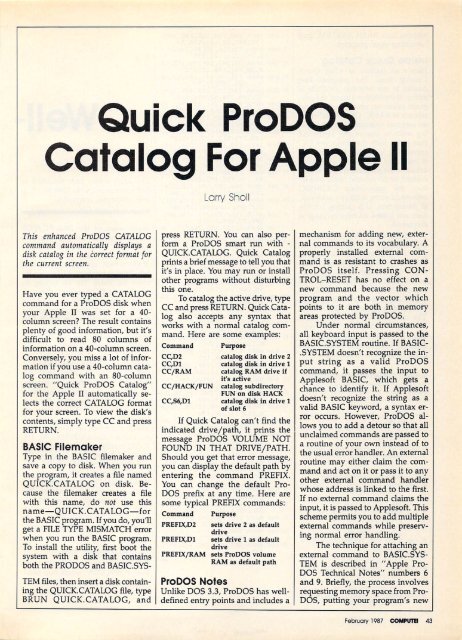Untitled - TRS-80 Color Computer Archive
Untitled - TRS-80 Color Computer Archive
Untitled - TRS-80 Color Computer Archive
- No tags were found...
Create successful ePaper yourself
Turn your PDF publications into a flip-book with our unique Google optimized e-Paper software.
QuickProDOSCatalog For AppleLarryShollThis enhanced ProDOS CATALOGcommand automatically displays adisk catalog in the correct format forthe current screen.Have you ever typed a CATALOGcommand for a ProDOS disk whenyour Apple II was set for a 40-column screen? The result containsplenty of good information, but it'sdifficult to read <strong>80</strong> columns ofinformation on a 40-column screen.Conversely, you miss a lot of information if you use a 40-column catalog command with an <strong>80</strong>-columnscreen. "Quick ProDOS Catalog"for the Apple II automatically selects the correct CATALOG formatfor your screen. To view the disk'scontents, simply type CC and pressRETURN.BASIC FilemakerType in the BASIC filemaker andsave a copy to disk. When you runthe program, it creates a file namedQUICK.CATALOG on disk. Because the filemaker creates a filewith this name, do not use thisname—QUICK.CATALOG—forthe BASIC program. If you do, you'llget a FILE TYPE MISMATCH errorwhen you run the BASIC program.To install the utility, first boot thesystem with a disk that containsboth the PRODOS and BASIC.SYS-TEM files, then insert a disk containing the QUICK.CATALOG file, typeBRUN QUICK.CATALOG, andpress RETURN. You can also perform a ProDOS smart run with -QUICK.CATALOG. Quick Catalogprints a brief message to tell you thatit's in place. You may run or installother programs without disturbingthisone.To catalog the active drive, typeCC and press RETURN. Quick Catalog also accepts any syntax thatworks with a normal catalog command. Here are some examples:CommandPurposeCC,D2 catalog disk in drive 2CC,D1 catalog disk in drive 1CC/RAM catalog RAM drive ifit's activeCC/HACK/FUN catalog subdirectoryFUN on disk HACKCC,S6,D1 catalog disk in drive 1of slot 6If Quick Catalog can't find theindicated drive/path, it prints themessage ProDOS VOLUME NOTFOUND IN THAT DRIVE/PATH.Should you get that error message,you can display the default path byentering the command PREFIX.You can change the default Pro-DOS prefix at any time. Here aresome typical PREFIX commands:CommandPurposePREFIX,D2 sets drive 2 as defaultdrivePREFIX,D1 sets drive 1 as defaultdrivePREFIX/RAM sets ProDOS volumeRAM as default pathProDOS NotesUnlike DOS 3.3, ProDOS has welldefinedentry points and includes amechanism for adding new, external commands to its vocabulary. Aproperly installed external command is as resistant to crashes asProDOS itself. Pressing CONTROL-RESET has no effect on anew command because the newprogram and the vector whichpoints to it are both in memoryareas protected by ProDOS.Under normal circumstances,all keyboard input is passed to theBASIC.SYSTEM routine. If BASIC-.SYSTEM doesn't recognize the input string as a valid ProDOScommand, it passes the input toApplesoft BASIC, which gets achance to identify it. If Applesoftdoesn't recognize the string as avalid BASIC keyword, a syntax error occurs. However, ProDOS allows you to add a detour so that allunclaimed commands are passed toa routine of your own instead of tothe usual error handler. An externalroutine may either claim the command and act on it or pass it to anyother external command handlerwhose address is linked to the first.If no external command claims theinput, it is passed to Applesoft. Thisscheme permits you to add multipleexternal commands while preserving normal error handling.The technique for attaching anexternal command to BASIC.SYSTEM is described in "Apple Pro-DOS Technical Notes" numbers 6and 9. Briefly, the process involvesrequesting memory space from Pro-DOS, putting your program's newFebruary 1987 COMPUTEl 43

















